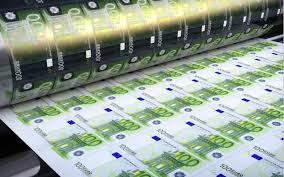Quantitative Easing is a monetary policy which is unconventional in nature and by dint of which the central bank of the nations tend to increase the money supply in the economy thus lowering interest rates by buying back government securities. Financial institutions are deluged by the capital and this promotes lending and liquidity.
RBI buys and sells bonds with Government of India (GOI) in order to stabilize the economy. If GOI wanted to reduce the fiscal deficit to be incurred due to high unplanned expenditure, then GOI would plan to sell government bonds to RBI. RBI would buy the bonds and provide money to GOI which would help the government to keep going efficiently and also to reduce the fiscal deficit.
Quantitative easing can be done with other banks and financial institutions as well. Banks may buy government bonds from RBI, which leads to reduction in money supply and lending. This would lead to increase in interest rates. Similarly, if RBI wants to increase the money supply the bonds has to be bought back by RBI from all finanicial institutions through which RBI can drop in money into the economy. Increase in money supply would lead to decrease in the interest rates and eventually decrease in inflation. But this decline will resist only for a short period of time which later will generate inflation.
Few economies in the present scenario have resorted to using QE as a pragmatic approach to revive from the catastrophic stance which they are witnessing on account of their declining balance sheets thus lending necessary credence to the efficacy of QE. However, few governments have expressed their strong disapproval towards QE despite of the dismal economy and balance sheets which appeared lugubrious than ever. This article will draw the necessary light towards one such economy.
China
Peoples Bank of China (PBOC) has instilled a 50 basis points reduction in its lenders reserve ratio resulting in injection of 600 billion yuans into the economy. However the biggest banks of the country still have to hold 19.5% of the deposits locked up. Their lending rate is 5.6% which far exceeds the rate that most of the nations practicing quantitative easing has resort to. The main reasons underlying these reductions were the depreciating Yuan, capital outflows, deflation risk and also the economic slowdown which the nation is witnessing. These steps adopted by China have laid the cornerstone for improving the economy which demands a strong backing by a stalwart fiscal policy.
However there lies a fallacy that superficially parallels this to the QE approaches adopted by USA, Japan and Europe. The main reasons behind these could be stated as follows:
Firstly the monetary policy adopted by the nation was quantitative and regulatory in nature by agency of which they decide the amount of money supply in the nation. The unconventional gambit adopted by PBOC was their pledged supplementary lending, which however is not a potent deviation from the tools adopted by them to relend over the past two years.
Secondly, it exaggerates the monetary stimulus of the nation. The loosening process of the PBOC is to replace the cash that has paved its way out of China and not majorly to infuse new capital into the economy.
The need for QE in China has not reached its zenith mainly because conventional monetary policies still hold a firm base in the nation unlike nations who have resorted to QE. PBOC deter the use of unconventional tools for easing as the relending process espouses the notion of avoiding money slash over the economy and certitude could not be laid on the ability of the financial markets to allocate credit to the segments as desired by the policy makers. Their main aim is to prevent credit boom by lowering the credit cost of the firms needing it and thus striking a balance between outright easing and targeted easing.
Click here for government certification in Accounting, Banking & Finance





31 Comments. Leave new
Good Article!
Something new to know 🙂
Great article!
Good efforts!!
Informative.
informative! 🙂
good work!
Informative.
Good effort.
very different and new article…
I understood something new.
Good One 😀
Good Work 😀
Good work!!!
good explanation!
Informative…well done
fresh information!Good work!
Good work!
Good efforts, Kannammai!
Nice article.
GOOD EFFORT
Informative!
Well written!
Different and well presented.
Good article
Great attempt at covering all the aspects of quantitative easing!
Informative!
Well elaborated.
Well written.
Amazing content
Very well written great job